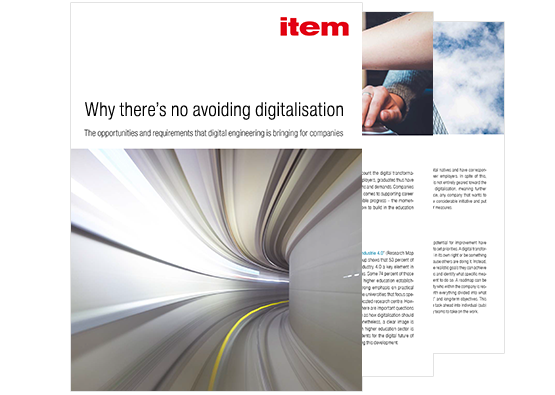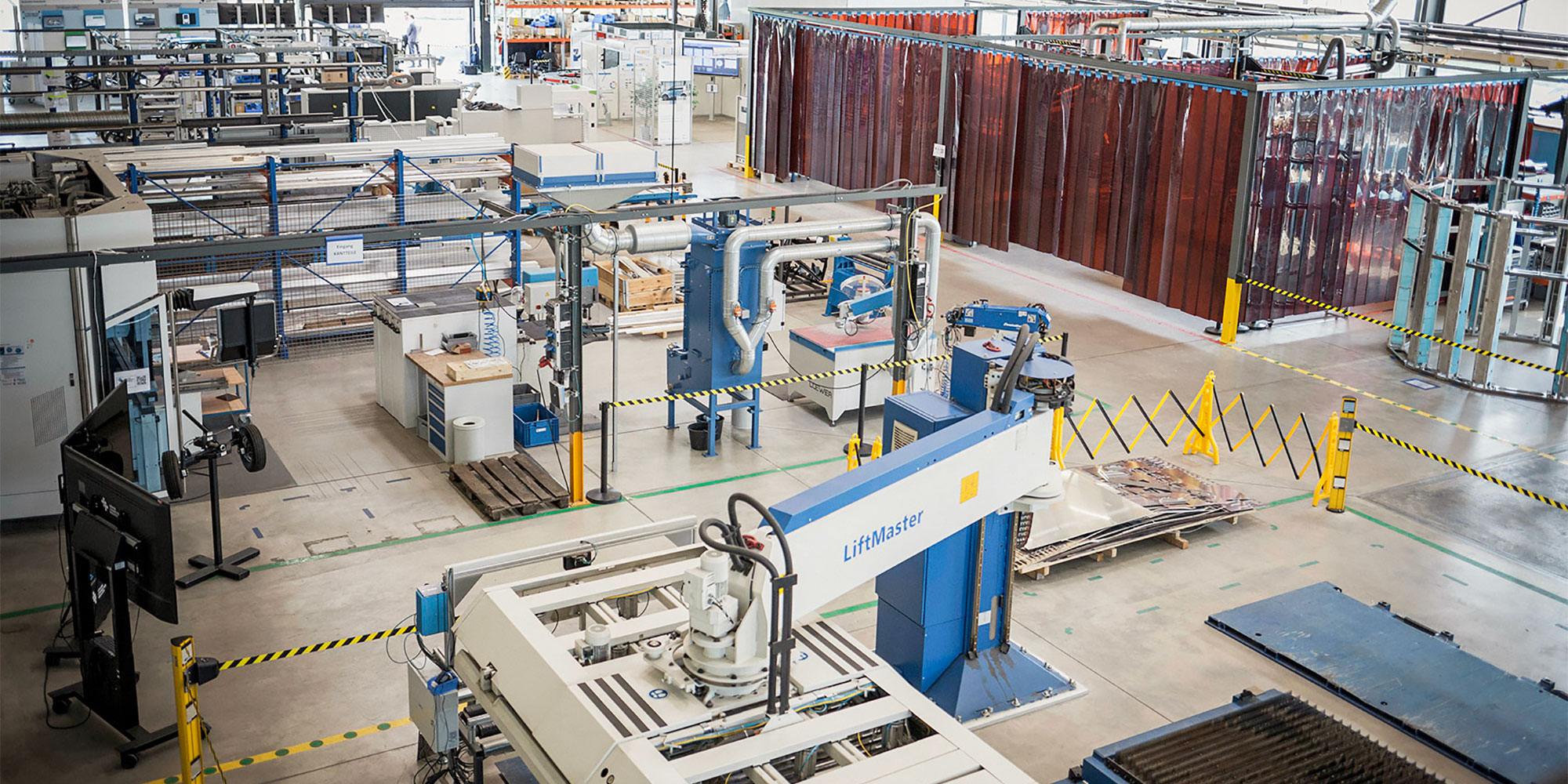Why everyone involved benefits when companies work together and combine their research on digitalisation.
Digitalisation is without doubt a key future trend, and there’s certainly plenty of ground to cover. Even a cursory glance at digitalisation in mechanical engineering reveals fascinating and innovative fields such as digital engineering, Industry 4.0, artificial intelligence and human-robot collaboration. Given this diversity and the ever-increasing speed of technical development, active dialogue between business and research, and also between companies, is clearly a vital part of getting fit for the challenges of the digital future. Collaboration in the digitalisation context creates stimulating new perspectives from which everyone involved can benefit – a real win-win situation. As a global market leader in building kit systems for industrial applications and a pioneer in digital design, item was quick to enter into partnerships of this kind. A few examples follow.

Digitalisation is a must
From training and in-house processes to business models, there’s no avoiding the digital revolution in mechanical engineering. Our white paper brings you bang up to date.
GET YOUR COPY NOW
Collaboration and research on wide-ranging aspects of digitalisation
At the Center Connected Industry (CCI) on the RWTH Aachen Campus, where an interdisciplinary team of researchers is working with industrial consortia to explore the digitalisation of production and logistics, a demonstration factory and various innovation labs are optimising the evaluation of new technology solutions. The focal points of the development partnership between item and the CCI are smart sensor technology, the Industrial Internet of Things (IIoT), the smart factory and 5G. The CCI’s digitalisation research infrastructure makes it possible to develop new, smart products for the item MB Building Kit System, Lean Production Building Kit System, Work Bench System and Linear System, before moving straight on to empirical testing. The overarching goal is to use intelligent systems and more flexible production techniques to make processes more efficient. This involves taking smart item products such as Linear Units to the next level with intelligent controllers. “Collaborating with the CCI makes it possible for us to work in a combined industry and research network, and to redesign both intralogistics and productive manufacturing processes,” says Jens-Uwe Gustmann, who is responsible for product management and business model development at item.
Collaborating with the CCI makes it possible for us to work in a combined industry and research network, and to redesign both intralogistics and productive manufacturing processes.
Adaptive Manufacturing Open Solutions (ADAMOS) GmbH also believes in active dialogue as a way of making progress. ADAMOS is a strategic alliance that promotes knowledge sharing on the future trends of Industry 4.0 and the Industrial Internet of Things amongst global market leaders in mechanical and factory equipment engineering. Its goal is to pool their expertise and create standards for digital production. Managing Director Dr. Tim Busse makes a point of emphasising the collaborative nature of ADAMOS. “We see ourselves as a community of like-minded partners engaging in an open, ongoing and subject-specific dialogue about digitalisation,” he says. The ADAMOS network offers item additional support in implementing its digitalisation projects. “We aim to use this potential, learn from partners with experience in the sector and expand our knowledge. The development of new business models relating to networked products is of particular interest to us,” explains Gustmann. At the same time, the other members of the alliance benefit from the know-how item offers regarding online tools in the mechanical engineering sector. For example, the Work Bench Configurator makes planning assembly work benches exceptionally quick and easy.

Configure industrial work benches online
Discover what the new Work Bench Configurator with its 3D view and smart functions can do – especially for ESD safety. Put together your very own manual production work bench without leaving your browser.
FIND OUT MORE
Innovative and time-saving software for digital mechanical engineering
Software from ipolog also significantly improves efficiency. Optimising material supply normally involves a great deal of effort. In addition to ergonomics, the type of material, the surface area / space available and supply concepts, relevant aspects also include the design and ordering of factory equipment. Significantly reducing the time required for planning thanks to its intelligent algorithms, the software of our cooperation partner ipolog visualises the planning process in 2D and 3D. Although placeholders can also be utilised when integrating factory equipment, true-to-scale representations of the solutions that are going to be used are preferable. These can be 3D models from CAD software or from ipolog’s own catalogue. Using the Lean Production Building Kit System to plan factory equipment offers several benefits. For one thing, standard FIFO racks from item are available in the ipolog software catalogue. For another, there’s a direct link to the item Engineeringtool, meaning templates and designs can be opened directly and tailored to the precise requirements. Roller conveyors, for example, are then recognised and the number of small load carriers that fit into the rack is determined. The selected factory equipment can ultimately be ordered from the item Online Shop.
The collaboration between Halocline and item offers additional benefits for users of the item Engineeringtool. They can import their item design into Halocline as a STEP file, add accessories and try out the finished design in a virtual environment.
Startup company Halocline is opening up a whole new dimension for a traditional method with its virtual cardboard engineering. Conventional cardboard engineering uses true-to-scale cardboard models that take up a lot of time and space. What’s more, these models cannot subsequently be modified any further. Halocline’s virtual reality version, on the other hand, uses three-dimensional boxes that are easy to produce. Even if you’re simulating an entire production area, you only need four square metres in the real world. Furthermore, the startup’s comprehensive VR software – also called Halocline – enables users to create their own racks, tables, work benches, etc. or take them from other programs and perform virtual testing using conventional VR glasses. The collaboration between Halocline and item offers additional benefits for users of the item Engineeringtool. They can import their item design into Halocline as a STEP file, add accessories and try out the finished design in a virtual environment. If they notice during this simulation that the dimensions need to be adjusted, for example, this can be done in a special Halocline module. The modified design can then be transferred to the item Engineeringtool and an order placed. An easy-to-use function for simplified data transfer and a dedicated item application catalogue will also be available in the future.
Are you interested in digitalisation and what the future holds for mechanical engineering? Then we have something that’s right up your street! Simply subscribe to the item blog by completing the box at the top right.





